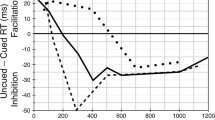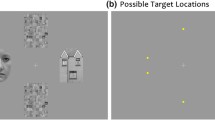Abstract
The development of orienting response (OR) theory has not been accompanied by many applications of the concept—most research still appears to be lab-based and “pure,” rather than “applied.” We present some examples from our own work in which the OR perspective has been applied in a wider context. These cover the exploration of processing deficits in autistic children, aspects of the “repression” of anxiety in elite athletes, and the locus of alcohol effects. Such applications of the OR concept in real-life situations seem a logical and, indeed,necessary step in the evolution of this area of psychophysiology.
Similar content being viewed by others
References
Asendorpf, J. B., and Scherer, K. R. (1983) The discrepant repressor: Differentiation between low anxiety, high anxiety, and repression of anxiety by autonomic-facial-verbal patterns of behavior.Journal of Personality and Social Psychology, 45, 1334–1346.
Barry, R. J. (1984) Preliminary processes in OR elicitation.Acta Psychologica, 55, 109–142.
Barry, R. J. (1987) Preliminary processes in orienting response elicitation. In P. K. Ackles, J. R. Jennings, and M. G. H. Coles (Eds.),Advances in Psychophysiology, Vol. 2. Connecticut: JAI Press.
Barry, R. J., and James, A. L. (1988) Coding of stimulus parameters in autistic, retarded, and normal children: Evidence for a two-factor theory of autism.International Journal of Psychophysiology, 6, 139–149.
Hodges, W. F. (1976) The psychophysiology of anxiety. In M. Zuckerman and C. D. Spielberger (Eds.),Emotions and Anxiety: New Concepts, Methods, and Applications. New York: Halsted Press.
James, A. L., and Barry, R. J. (1980) Respiratory and vascular responses to simple visual stimuli in autistics, retardates and normals.Psychophysiology, 17, 541–547.
James, A. L., and Barry, R. J. (1984) Cardiovascular and electrodermal responses to simple stimuli in autistic, retarded and normal children.International Journal of Psychophysiology, 1, 179–193.
Lader, M. H., and Marks, I. (1971)Clinical Anxiety. London: William Heinemann.
Ritvo, E. R., and Freeman, B. J. (1978) National society for autistic children. Definition of the syndrome of autism.Journal of Autism and Childhood Schizophrenia, 8, 162–167.
Sokolov, E. N. (1963)Perception and the Conditioned Reflex. Oxford: Pergamon.
Spielberger, C. D. (1972)Anxiety: Current Trends in Theory and Research. New York: Academic Press.
Tremayne, P. and Barry, R. J. (1988) An application of psychophysiology in sports psychology: Heart rate responses to relevant and irrelevant stimuli as a function of anxiety and defensiveness in elite gymnasts.International Journal of Psychophysiology, 6, 1–8.
Weinberger, D. A., Schwartz, G. E., and Davidson, R. J. (1979) Low-anxious, high-anxious, and repressive coping styles: Psychometric patterns and behavioral and physiological responses to stress.Journal of Abnormal Psychology, 88, 369–380.
Author information
Authors and Affiliations
Additional information
With a Comment by E. N. Sokolov
Rights and permissions
About this article
Cite this article
Tremayne, P., Barry, R.J. Applied orienting response research: Some examples. Pav. J. Biol. Sci. 25, 132–141 (1990). https://doi.org/10.1007/BF02974267
Issue Date:
DOI: https://doi.org/10.1007/BF02974267




